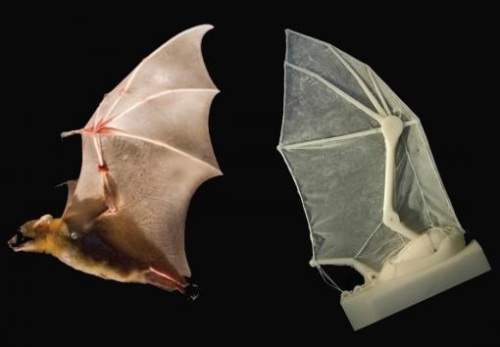Animal-inspired technology has become very popular. Researchers use fireflies to create better LEDs, incorporate honey bee brains into robots, and create muscles that can camouflage like squid. Now, engineering has taken bio-inspiration one step further to create a robotic bat wing that has the potential to impact small aircraft design.

On the left, a real bat. On the right, the robotic bat created by Brown University researchers. (Image via Breuer and Swartz labs/Brown University)
Brown University researchers designed a robotic bat that is providing key information about the science behind flight in real bats, including ligament function, skin elasticity, skeletal flexibility, and strokes.
The bat
Bat wings are very intricate in design. They span most of the length of a bat’s body and are supported and moved by two arm bones and five digits. Their bones are covered by an elastic skin that can stretch up to 400% without even tearing. Their wings contain 25 joints and 34 degrees of freedom.
The team of researchers created a robot that was very similar to an actual bat. It’s about eight inches long with plastic 3D-printed bones, skin made of a silicon elastomer, and joints activated by servo motors that pull on tendon-like cables, which pull on the joints.
The study
The robot’s wings mimic that of the dog-faced fruit bat. It was designed to flap while attached to a force transducer in a wind tunnel. As the wings flap, the force transducer records the aerodynamic forces created by the moving wind.
The Brown University team was able to evaluate the energy required to execute wing movements by measuring the power output of the three servo motors that control the robot’s seven moveable joints.
The information collected in the study could never be produced by real bats because they would not be able to fly while connected to instruments that record these aerodynamic forces.
“We can’t ask a bat to flap at a frequency of eight hertz then raise it to nine hertz so we can see what difference that makes,” said Joseph Bahlamn, graduate student at Brown who led the study. “They don’t really cooperate that way.”
By using the robotic bat, the team could control each of its movements individually and make specific adjustments to gain a better understanding of bat flight. In their study, they aimed to learn more about the effects of wing beat frequency on lift and measure the relationship between kinematic parameters, aerodynamic forces, and energetics.
In the paper “Design and characterization of a multi-articulated robotic bat wing” that appeared in the journal Bioisnpiration and Biomimetics, the team discusses some of their studies.
One experiment conducted explored the aerodynamic effects of wing folding. Wing folding occurs in bats and some birds during their upstroke while in flight. The team already discovered that wing folding helped bats conserve energy, but now wanted to see what kind of effects it had on aerodynamic forces. What they learned was that wing folding had a lot to do with lift.
When an animal flaps, it creates positive lift by the downstroke, which is then undone by the upstroke, which creates negative lift. The team tested the robot without wing folding and found that the folding actually increases net lift by 50% because it decreases negative lift.
Many issues occurred while developing the robotic bat, which in turn helped the team learn more about the animal’s composition.
“We learned a lot about how bats work from trying to duplicate them and having things go wrong,” said Bahlman. For example, in order to hold the weak elbow bones together, the team used steel that resembled a ligament. To reinforce the wing membranes, they used elastic threads that ended up resembling tendon and muscles.
Now that they have a fully operational robotic bat, the team plans to test different wing materials and different amounts of flexibility on the bones.
Watch the robotic bat in action in the quick video below.
Advertisement





